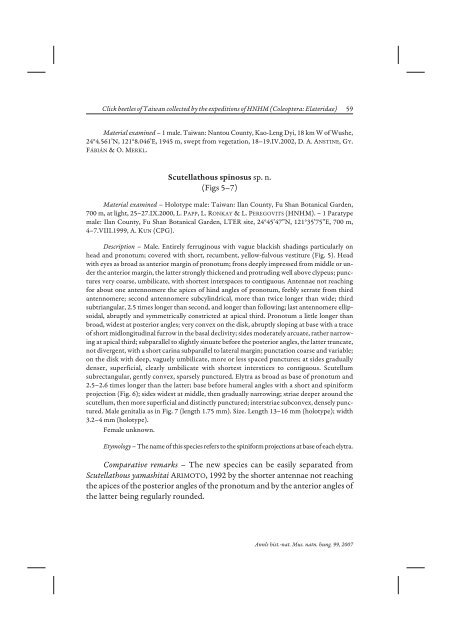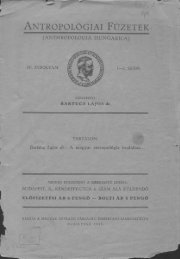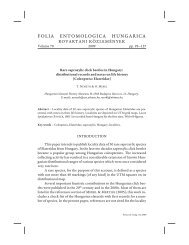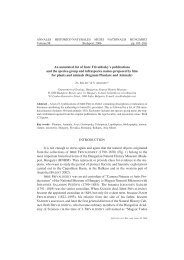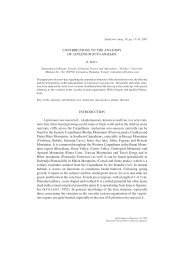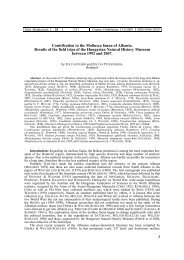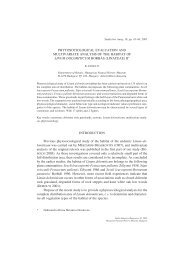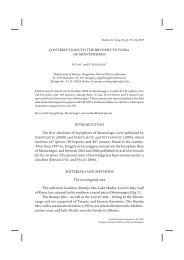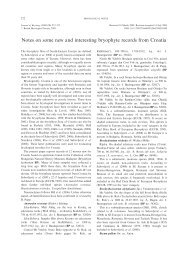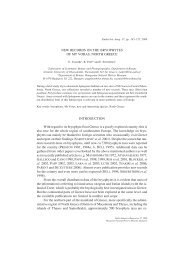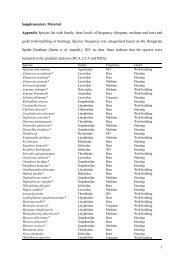Create successful ePaper yourself
Turn your PDF publications into a flip-book with our unique Google optimized e-Paper software.
Click beetles of Taiwan collected by the expeditions of HNHM (Coleoptera: Elateridae) 59Material exam<strong>in</strong>ed – 1 male. Taiwan: Nantou County, Kao-Leng Dyi, 18 km W of Wushe,24°4.561’N, 121°8.046’E, 1945 m, swept from vegetation, 18–19.IV.2002, D. A. ANSTINE, GY.FÁBIÁN & O. MERKL.Scutellathous sp<strong>in</strong>osus sp. n.(Figs 5–7)Material exam<strong>in</strong>ed – Holotype male: Taiwan: Ilan County, Fu Shan Botanical Garden,700 m, at light, 25–27.IX.2000, L. PAPP,L.RONKAY &L.PEREGOVITS (HNHM). – 1 Paratypemale: Ilan County, Fu Shan Botanical Garden, LTER site, 24°45’47”N, 121°35’75”E, 700 m,4–7.VIII.1999, A. KUN (CPG).Description – Male. Entirely ferrug<strong>in</strong>ous with vague blackish shad<strong>in</strong>gs particularly onhead and pronotum; covered with short, recumbent, yellow-fulvous vestiture (Fig. 5). Headwith eyes as broad as anterior marg<strong>in</strong> of pronotum; frons deeply impressed from middle or underthe anterior marg<strong>in</strong>, the latter strongly thickened and protrud<strong>in</strong>g well above clypeus; puncturesvery coarse, umbilicate, with shortest <strong>in</strong>terspaces to contiguous. Antennae not reach<strong>in</strong>gfor about one antennomere the apices of h<strong>in</strong>d angles of pronotum, feebly serrate from thirdantennomere; second antennomere subcyl<strong>in</strong>drical, more than twice longer than wide; thirdsubtriangular, 2.5 times longer than second, and longer than follow<strong>in</strong>g; last antennomere ellipsoidal,abruptly and symmetrically constricted at apical third. Pronotum a little longer thanbroad, widest at posterior angles; very convex on the disk, abruptly slop<strong>in</strong>g at base with a traceof short midlongitud<strong>in</strong>al furrow <strong>in</strong> the basal declivity; sides moderately arcuate, rather narrow<strong>in</strong>gat apical third; subparallel to slightly s<strong>in</strong>uate before the posterior angles, the latter truncate,not divergent, with a short car<strong>in</strong>a subparallel to lateral marg<strong>in</strong>; punctation coarse and variable;on the disk with deep, vaguely umbilicate, more or less spaced punctures; at sides graduallydenser, superficial, clearly umbilicate with shortest <strong>in</strong>terstices to contiguous. Scutellumsubrectangular, gently convex, sparsely punctured. Elytra as broad as base of pronotum and2.5–2.6 times longer than the latter; base before humeral angles with a short and sp<strong>in</strong>iformprojection (Fig. 6); sides widest at middle, then gradually narrow<strong>in</strong>g; striae deeper around thescutellum, then more superficial and dist<strong>in</strong>ctly punctured; <strong>in</strong>terstriae subconvex, densely punctured.Male genitalia as <strong>in</strong> Fig. 7 (length 1.75 mm). Size. Length 13–16 mm (holotype); width3.2–4 mm (holotype).Female unknown.Etymology – The name of this species refers to the sp<strong>in</strong>iform projections at base of each elytra.Comparative remarks – The new species can be easily separated fromScutellathous yamashitai ARIMOTO, 1992 by the shorter antennae not reach<strong>in</strong>gthe apices of the posterior angles of the pronotum and by the anterior angles ofthe latter be<strong>in</strong>g regularly rounded.Annls hist.-nat. Mus. natn. hung. 99, 2007


